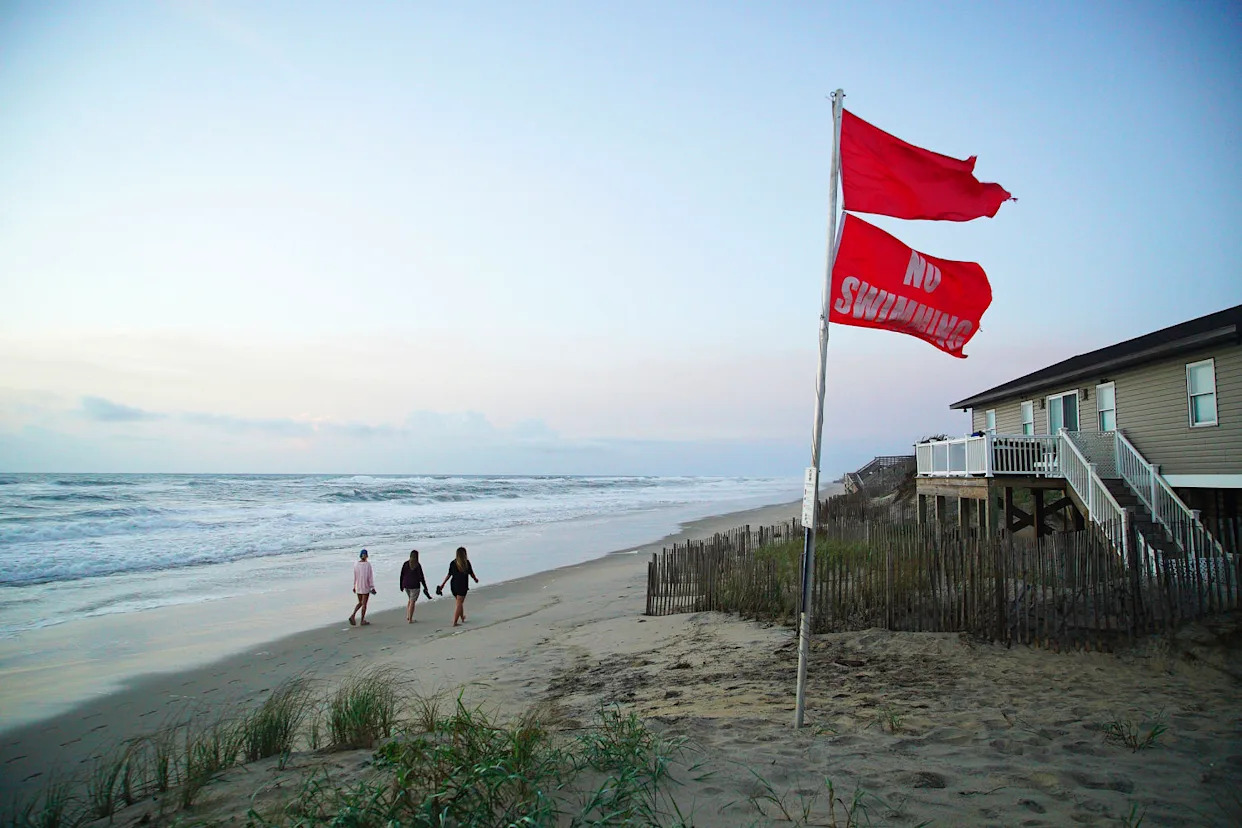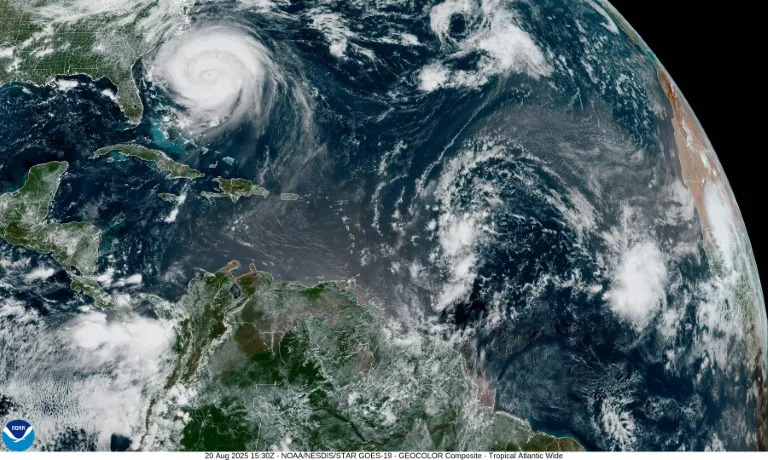
A tropical storm warning has been issued for North Carolina as Hurricane Erin churns up the east coast of the U.S. as a Category 2 storm.
The National Hurricane Center said Wednesday morning that the storm was about 365 miles south-southeast of Cape Hatteras, North Carolina. A state of emergency has been declared for the entire state as the storm had maximum sustained winds of 110 mph and was moving north at 13 mph, the hurricane center said in its 11 a.m. EDT update.
Erin is already a large hurricane, with winds extending outward up to 90 miles from the center and tropical-storm-force winds extending outward up to 265 miles from the center. It is expected to remain a hurricane this week while growing in size as it continues its trek across the Atlantic and eventually turns out to sea.
"I want to emphasize the importance of taking this storm seriously, because it's a serious storm and conditions can deteriorate quickly," North Carolina Gov. Josh Stein said at a Wednesday press conference.
The storm is expected to take a turn north-northeast on Wednesday and move over the western Atlantic Ocean between the east coast of the U.S. and Bermuda, before passing south of Atlantic Canada into the weekend, the hurricane center said.
Erin will make its closest pass to the U.S. on Thursday, when the onshore winds will be strongest, leading to coastal flood concerns and dangerous rip currents. The heavy rain will remain offshore so that the strong winds will be the most noticeable impact.
North Carolina is anticipating coastal flooding from massive waves, tropical-storm-force winds and tidal and storm surges for much of the state shoreline, especially the Outer Banks, as well as life-threatening rip currents for most of the week, Stein said, adding, "No one should be in the ocean."
Erin could strengthen on Wednesday and Thursday but is expected to begin weakening by Friday, the hurricane center said.
"Regardless of the track of the center of the storm, dangerous conditions can be felt far from the eye, especially with the system as large as Erin, regardless of her track," North Carolina Emergency Management Director Will Ray said Wednesday.
The 11 a.m. advisory from the National Hurricane Center said the tropical storm warning now covers north of the border of North Carolina and Virginia to Chincoteague, Virginia.
A storm surge warning is effect from Cape Lookout to Duck, North Carolina, where 2 to 4 feet of storm surge flooding is possible along the coast, according to the hurricane center.
Additionally, 1 to 2 inches of rain could hit the Outer Banks on Wednesday and Thursday.
"Weather conditions expected to deteriorate along the coast of North Carolina by this evening," the hurricane center said. "Beachgoers are cautioned against swimming at most U.S. East Coast beaches due to life-threatening rip currents."
Video from North Carolina shows major waves rolling onto land, flooding roads and beachfront homes.
There were 4 to 5 inches of standing water north of Hatteras Village as of 9 a.m. on Wednesday, the Dare County Sheriff's Office said in a Facebook post. Crews were working to build dunes in the area.
Swells caused by the hurricane will affect the Bahamas, Bermuda, and the east coast of the U.S. over the next several days, with rough oceans expected to produce life-threatening surf and rip currents, the hurricane center said.
"Hurricane Erin is already creating extremely dangerous and life threatening rip currents for all of the North Carolina coast that will linger through the week," Ray said. "We've seen a high number of rescues along the coast, and you should avoid swimming anywhere on the North Carolina coast right now."
Evacuation orders have been implemented for Dare and Hyde counties in North Carolina with shelters and recovery centers open across the state, Ray said. North Carolina has requested major disaster declaration for public assistance from the federal government, which would provide additional recovery resources to those impacted, Ray added.
"If you have not evacuated, make sure you batten down the hatches," Stein said Thursday.
The National Weather Service in Jacksonville, Florida, also warned of dangerous surf conditions and rip tides on Wednesday.
"Dangerous Marine & Surf Conditions worsen today as waves & winds increase. Deadly rip currents, high surf & minor tidal flooding around high tide this evening at the coast," the NWS said on X. "Stay out of the ocean!"
Other states this week have similarly issued warnings to stay out of the ocean, including in New Jersey and New York, as beaches in North Carolina already reported several rip current rescues on Tuesday.
"We are hyper, hyper concerned, first and foremost about complacency, particularly when the weather is really good Thursday afternoon through Sunday, in terms of people sort of thinking about going in the water because these rip currents are brutal," New Jersey Gov. Phil Murphy said at a news conference Tuesday afternoon. "Please, don't go into the water."
New York Gov. Kathy Hochul on Tuesday prohibited swimming at Long Island beaches because of the swells that are expected in the area. Swimming at New York City beaches is also barred on Wednesday and Thursday.
Coastal towns such as Wrightsville Beach, North Carolina, Rehoboth Beach, Delaware, and Wildwood, New Jersey, have issued no-swimming advisories for the week.
Rip currents were observed on Tuesday, the National Weather Service in Wilmington said on X. The agency warned of "dangerous rips & rough surf" that will continue through Friday.
Beach closures moved north on Wednesday, with Nantucket Island in Massachusetts issuing a no-swim advisory. The area is expecting surf up to 12 feet on Wednesday and 25 feet on Thursday.
Stein on Wednesday warned against getting news about Hurricane Erin from social media as AI misinformation floods channels.
"It is just too easy for salacious, really dramatic stories to take root and then and spread like wildfire, even in a hurricane, because that's what people click on," Stein said. "If you see something on social media that sparks your interest, just go to a traditional website or news source and find out whether it's true."
This article was originally published on NBCNews.com








Comments